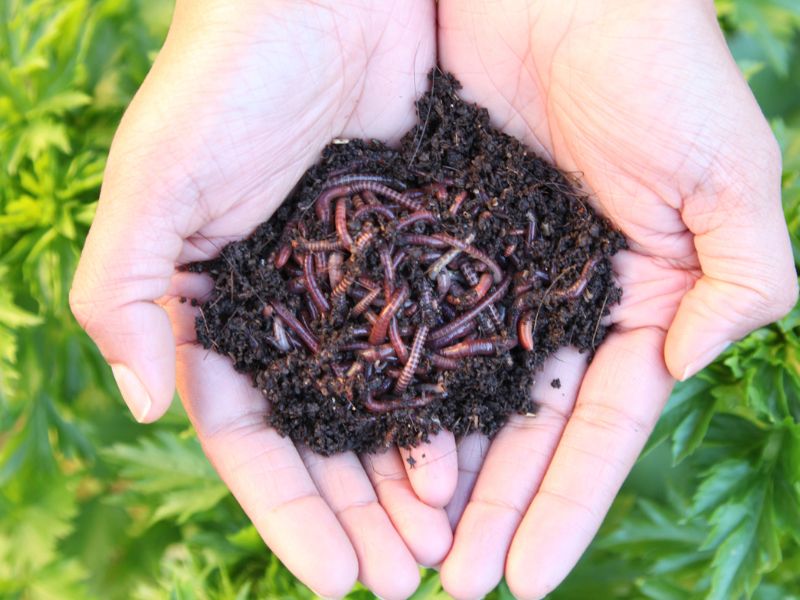Grasping Red Wiggler Composting: Vital Practices for Healthy Composting
Grasping Red Wiggler Composting: Vital Practices for Healthy Composting
Blog Article
The Advantages of Making Use Of Red Wiggler Composting: Discover Exactly How This Eco-Friendly Strategy Enhances Soil Health And Wellness and Promotes Plant Development
The technique of red wiggler composting presents a range of advantages that extend past simple waste monitoring, providing considerable advantages for soil wellness and plant vigor. By transforming natural products into nutrient-rich worm castings, this eco-friendly technique not only improves dirt structure yet also cultivates a thriving ecosystem of advantageous bacteria.
Benefits of Vermicomposting
Vermicomposting, using red wiggler worms, supplies many benefits that add to sustainable waste management and soil improvement. Among the key benefits is its performance in organic waste decomposition (Red Wiggler Composting). Red wigglers can eat their body weight in natural issue daily, dramatically decreasing cooking area scraps and lawn waste, which decreases land fill payments
Additionally, vermicomposting runs at cooler temperatures compared to conventional composting techniques, allowing for year-round processing and lessening odor problems. The presence of red wigglers accelerates the break down of products, producing nutrient-rich spreadings that enhance microbial task in the compost.
Furthermore, this approach fosters a closed-loop system where waste is changed into an important resource, promoting eco-friendly balance. The convenience of handling a vermicomposting system makes it obtainable for both urban and country setups, motivating area participation in lasting techniques.
Enhancing Soil Nutrients
The nutrient-rich castings generated by red wigglers serve as a powerful amendment for enhancing dirt quality. These worm spreadings are rich in essential macro and trace elements such as nitrogen, phosphorus, calcium, magnesium, and potassium, which are important for plant health and development. Unlike synthetic fertilizers, which can bring about nutrition leaching and dirt degradation, worm spreadings offer a slow-release resource of nutrients that improve soil framework and fertility over time.
Furthermore, the raw material found in worm castings enhances soil oygenation and water retention. This is particularly beneficial for plants, as it assists in better root advancement and advertises overall plant vitality. The balanced nutrient profile of worm castings additionally decreases the risk of nutrient shed that is usually related to chemical fertilizers.
Integrating red wiggler garden compost into garden soil or potting mixes not just improves the nutrient content however likewise sustains lasting horticulture techniques - Red Wiggler Composting. By utilizing this environment-friendly technique, garden enthusiasts can cultivate healthier plants, improve crop yields, and contribute favorably to dirt ecosystem health and wellness. Generally, boosting dirt nutrients via red wiggler composting is a practical strategy to lasting agriculture and horticulture
Promoting Beneficial Microorganisms
Just how can red wiggler composting improve the microbial variety in soil? This process cultivates a diverse selection of helpful germs, fungis, and protozoa, which are necessary for soil wellness.
The castings generated by red wigglers are including microorganisms that advertise nutrient biking and enhance dirt structure. These microbial neighborhoods play an essential duty in breaking down raw material, launching important nutrients that plants can soak up. Additionally, a lot of these microorganisms add to dirt aggregation, boosting aeration and water retention.
Additionally, the visibility of diverse microbial populaces assists subdue soil-borne diseases by outcompeting dangerous pathogens. This all-natural biocontrol device is important for keeping healthy and balanced plant growth. In verdict, red wiggler composting not just enhances the dirt with nutrients but likewise promotes a lively microbial area, which is critical for lasting farming practices and producing resistant communities.
Lowering Kitchen Waste
Often ignored in waste monitoring conversations, red wiggler composting offers an efficient service for minimizing cooking area waste. By making use of red wigglers, organic kitchen scraps that would usually wind up in land fills can be transformed into nutrient-rich compost. This process considerably decreases the volume of waste created, consequently relieving stress on waste monitoring systems and adding to lasting living techniques.

In addition, red wiggler composting can be quickly executed in both city and country setups, making it available to a wide target market. This technique urges people to embrace environment-friendly methods in their day-to-days live, fostering a better recognition of waste monitoring and ecological responsibility. Inevitably, red wiggler composting functions as a efficient and useful strategy for lowering kitchen waste while advertising a more lasting lifestyle.
Improving Plant Development
Utilizing red wiggler compost not just addresses kitchen area waste decrease but likewise significantly improves plant development. The nutrient-rich compost created by these earthworms Red Wiggler Composting contains necessary macronutrients and micronutrients, including nitrogen, phosphorus, and potassium, which are crucial for plant development. This natural fertilizer adds to improved dirt framework, helping with much better oygenation and water retention, which are crucial for healthy and balanced origin systems.
In addition, red wiggler compost is including helpful bacteria that promote soil health and wellness. These microbes assist in breaking down organic matter, making nutrients much more easily accessible to plants. The visibility of beneficial germs and fungis cultivates a cooperative relationship with plant roots, bolstering nutrient uptake and enhancing resistance to illness.
Additionally, utilizing red wiggler garden compost can assist control dirt pH levels, creating an optimal environment for varied plant varieties. The slow-release nature of the nutrients ensures that plants receive a steady supply over time, reducing the risk of nutrient leaching and minimizing the need for chemical plant foods.
Verdict

The technique of red wiggler composting offers an array of advantages that expand beyond easy waste monitoring, providing significant advantages for soil health and wellness and plant vitality.Vermicomposting, making use of red wiggler worms, uses numerous advantages that add to lasting waste administration and soil enhancement. Red Wiggler Composting. browse around this web-site Unlike artificial plant foods, which can lead to nutrient leaching and soil deterioration, worm spreadings provide a slow-release source of nutrients that enhance dirt framework and fertility over time
Overall, improving dirt nutrients via red wiggler composting is a practical approach to sustainable agriculture and horticulture.
In verdict, the application of red wiggler composting presents significant advantages for soil health and wellness and plant development.
Report this page